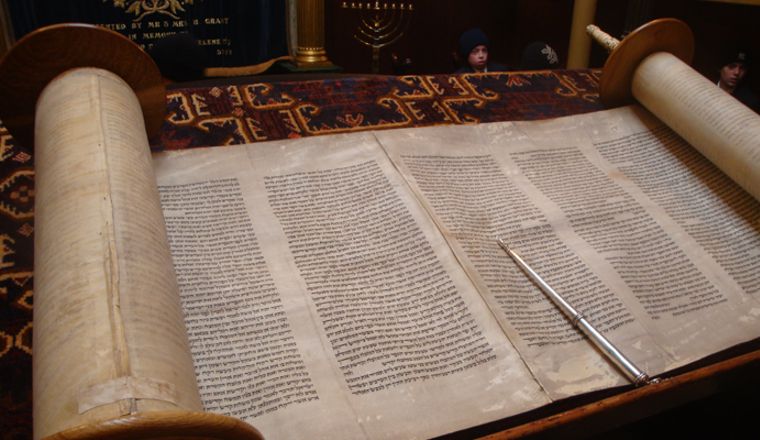Tanakh (the Hebrew Bible) is Judaism’s foundational text. The word “Tanakh” is an acronym of its three parts: Torah (The Five Books of Moses), Nevi’im (Prophets), and Ketuvim (Writings). It contains stories, law, poetry, and teachings about God and humanity.
There are 39 books in the Old Testament, starting with Genesis and ending with Malachi. They’re arranged according to the subject matter in one long list. Tanakh, on the other hand, contains only 24 books. Hebrew and Christian Bibles differ in number because 1 Samuel and 2 Samuel are combined into Samuel. The same goes for King 1 and 2 and the Chronicles.
The Tanakh is in the Hebrew language, while the Old Testament exists in various languages, mostly translated from Tanakh.
Click here for more information on the Old Testament.
Torah
The Torah is the combination of the first five books of the Tanakh. The Torah is also known as the Five Books of Moses.
GENESIS
Creation, the beginning of mankind, and stories of the patriarchs and matriarchs.
EXODUS
The Israelites’ enslavement in Egypt, miraculous redemption, the giving of the Torah, and building of the Mishkan (Tabernacle).
LEVITICUS
Laws of sacrificial worship in the Mishkan (Tabernacle), ritual purity, and other topics like agriculture, ethics, and holidays.
NUMBERS
Wanderings of the Israelites in the desert, census, rebellion, spies and war, interspersed with laws.
DEUTERONOMY
Moses’ final speeches, recalling events of the desert, reviewing old laws, introducing new ones, and calling for faithfulness to God.
Nevi’im / The Prophets
There are eight books in the Nevi*im: Joshua, Judges, Samuel, and Kings in the Former Prophets; Isaiah, Jeremiah, Ezekiel in the Latter Prophets; and the Twelve Prophets in the Latter Prophets: Hosea, Joel, Amos, Zephaniah, Obadiah, Jonah, Micah, Nahum, Habakkuk, Haggai, Zechariah, and Malachi.
JOSHUA
The Israelites enter, conquer, and settle Israel under the leadership of Joshua.
JUDGES
Cycles of sin, foreign oppression, repentance, and redemption through leaders appointed by God.
I SAMUEL
The prophet Samuel, the advent of monarchy with the reign of Saul, and the rise of a young David.
II SAMUEL
King David’s triumphs and challenges as he establishes a united kingdom with Jerusalem as its capital.
I KINGS
Solomon’s kingship, construction of the Temple, a schism in the kingdom, and Elijah the Prophet.
II KINGS
Stories and miracles of the prophet Elisha, the decline of Israel’s kingdoms, and the Temple’s destruction.
ISAIAH
Criticism of religious corruption, calls for change, and descriptions of a utopian future.
JEREMIAH
Warnings of Jerusalem’s destruction and demands for repentance, largely rejected by the people, some of whom torture and persecute him.
EZEKIEL
Dramatic symbolism conveying rebuke or hope, and visions of a future Temple.
HOSEA
Rebuke of Israel for abandoning God, comparing their relationship to that of unfaithful lovers.
JOEL
A locust plague, a call to repent, and a promise of judgement for Israel’s oppressors.
AMOS
Condemnation of oppression and arrogance in the nations and Israel, and a call for reform.
OBADIAH
The shortest book in Tanakh, at just 21 verses, predicting the downfall of the kingdom of Edom.
JONAH
A great fish swallows Jonah when he tries to escape his mission of prophecy, and Jonah repents.
MICAH
Berating of Israel and its leadership for insincere ritual worship, and calls for justice and kindness.
NAHUM
A celebratory prophecy about the downfall of the Assyrian empire, an oppressor of Israel.
HABAKKUK
Charging God to explain the unjust success of the Babylonians, God’s response, and a prayer.
ZEPHANIAH
Warnings of the destruction God will wreck on the unfaithful and calls for justice and humility.
HAGGAI
Urgent calls to build the Second Temple and descriptions of its future glory.
ZECHARIAH
Symbolic visions of redemption, explained by angels, and descriptions of the end of days.
MALACHI
Criticism of disingenuous ritual worship and descriptions of God’s future blessings.
Ketuvim / Writings
The Ketuvim include the Psalms, Proverbs, Job, Daniel, Ezra, Nehemiah, and Chronicles and a collection of religious poetry and wisdom literature known as the “Five Megillot.”
PSALMS
Poems of despair, hope, gratitude, and supplication to God, attributed to David and others.
PROVERBS
Guidance for living a wise, moral, and righteous life, in the form of poems and short statements.
JOB
Satan convinces God to strike a righteous man with tragedy, spurring conversations about suffering.
SONG OF SONGS
Poetic conversations of two lovers, traditionally read as a metaphor for God and Israel.
RUTH
A Moabite widow remains loyal to her mother-in-law and to Israel, embarking on a new beginning.
LAMENTATIONS
Laments of Jerusalem’s destruction, grappling with theological explanations.
ECCLESIASTES
An exploration of the meaning of life, reckoning with death, futility, and purpose.
ESTHER
Esther becomes queen of Persia and foils a plot to destroy the Jews, establishing the Purim holiday.
DANIEL
A Jewish advisor to Babylonian kings interprets dreams and miraculously escapes danger.
EZRA
Rebuilding the Temple after decades of exile and religious revival led by Ezra the scribe.
NEHEMIAH
Rebuilding Jerusalem’s walls and the nation’s commitment to observe the commandments.
I CHRONICLES
Recounts of events in the Torah and early Prophets, focusing on King David.
II CHRONICLES
Recounts of events in the Prophets, from Solomon through the First Temple’s destruction.
Sources: The Tanakh, Bible, AllTheDifferences.com, and Sefaria.org.







